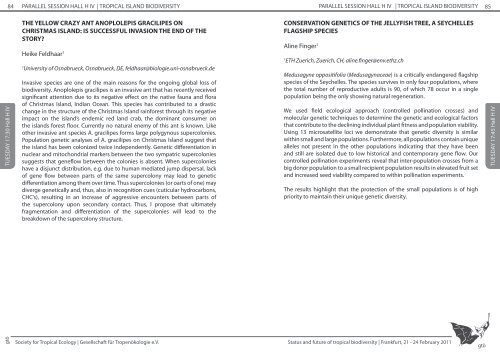Abstract booklet - gtö – Society for Tropical Ecology
Abstract booklet - gtö – Society for Tropical Ecology
Abstract booklet - gtö – Society for Tropical Ecology
You also want an ePaper? Increase the reach of your titles
YUMPU automatically turns print PDFs into web optimized ePapers that Google loves.
84 PARALLEL SESSION HALL H IV | TROPICAL ISLAND BIODIVERSITYPARALLEL SESSION HALL H IV | TROPICAL ISLAND BIODIVERSITY 85THE YELLOW CRAZY ANT ANOPLOLEPIS GRACILIPES ONCHRISTMAS ISLAND: IS SUCCESSFUL INVASION THE END OF THESTORY?Heike Feldhaar 1CONSERVATION GENETICS OF THE JELLYFISH TREE, A SEYCHELLESFLAGSHIP SPECIESAline Finger 11ETH Zuerich, Zuerich, CH, aline.finger@env.ethz.chTUESDAY 17:30 Hall H IV1University of Osnabrueck, Osnabrueck, DE, feldhaar@biologie.uni-osnabrueck.deInvasive species are one of the main reasons <strong>for</strong> the ongoing global loss ofbiodiversity. Anoplolepis gracilipes is an invasive ant that has recently receivedsignificant attention due to its negative effect on the native fauna and floraof Christmas Island, Indian Ocean. This species has contributed to a drasticchange in the structure of the Christmas Island rain<strong>for</strong>est through its negativeimpact on the island’s endemic red land crab, the dominant consumer onthe islands <strong>for</strong>est floor. Currently no natural enemy of this ant is known. Likeother invasive ant species A. gracilipes <strong>for</strong>ms large polygynous supercolonies.Population genetic analyses of A. gracilipes on Christmas Island suggest thatthe island has been colonized twice independently. Genetic differentiation innuclear and mitochondrial markers between the two sympatric supercoloniessuggests that geneflow between the colonies is absent. When supercolonieshave a disjunct distribution, e.g. due to human mediated jump dispersal, lackof gene flow between parts of the same supercolony may lead to geneticdifferentiation among them over time. Thus supercolonies (or oarts of one) maydiverge genetically and, thus, also in recognition cues (cuticular hydrocarbons,CHC’s), resulting in an increase of aggressive encounters between parts ofthe supercolony upon secondary contact. Thus, I propose that ultimatelyfragmentation and differentiation of the supercolonies will lead to thebreakdown of the supercolony structure.Medusagyne oppositifolia (Medusagynaceae) is a critically endangered flagshipspecies of the Seychelles. The species survives in only four populations, wherethe total number of reproductive adults is 90, of which 78 occur in a singlepopulation being the only showing natural regeneration.We used field ecological approach (controlled pollination crosses) andmolecular genetic techniques to determine the genetic and ecological factorsthat contribute to the declining individual plant fitness and population viability.Using 13 microsatellite loci we demonstrate that genetic diversity is similarwithin small and large populations. Furthermore, all populations contain uniquealleles not present in the other populations indicating that they have beenand still are isolated due to low historical and contemporary gene flow. Ourcontrolled pollination experiments reveal that inter-population crosses from abig donor population to a small recipient population results in elevated fruit setand increased seed viability compared to within pollination experiments.The results highlight that the protection of the small populations is of highpriority to maintain their unique genetic diversity.TUESDAY 17:45 Hall H IVgtö<strong>Society</strong> <strong>for</strong> <strong>Tropical</strong> <strong>Ecology</strong> | Gesellschaft für Tropenökologie e.V. Status and future of tropical biodiversity | Frankfurt, 21 - 24 February 2011gtö












